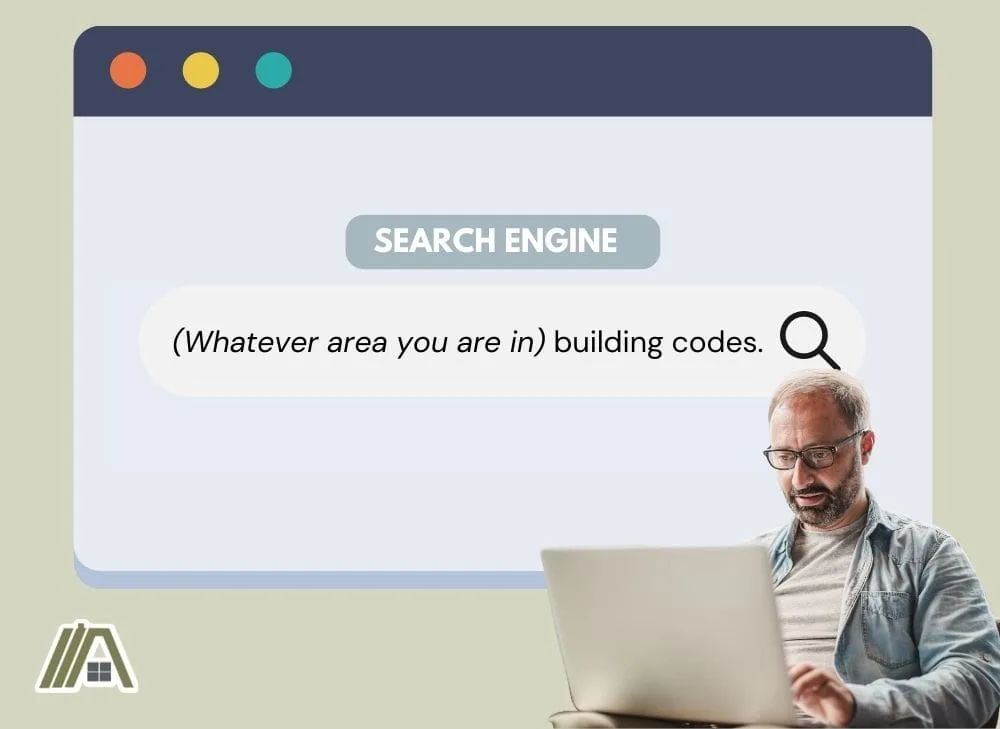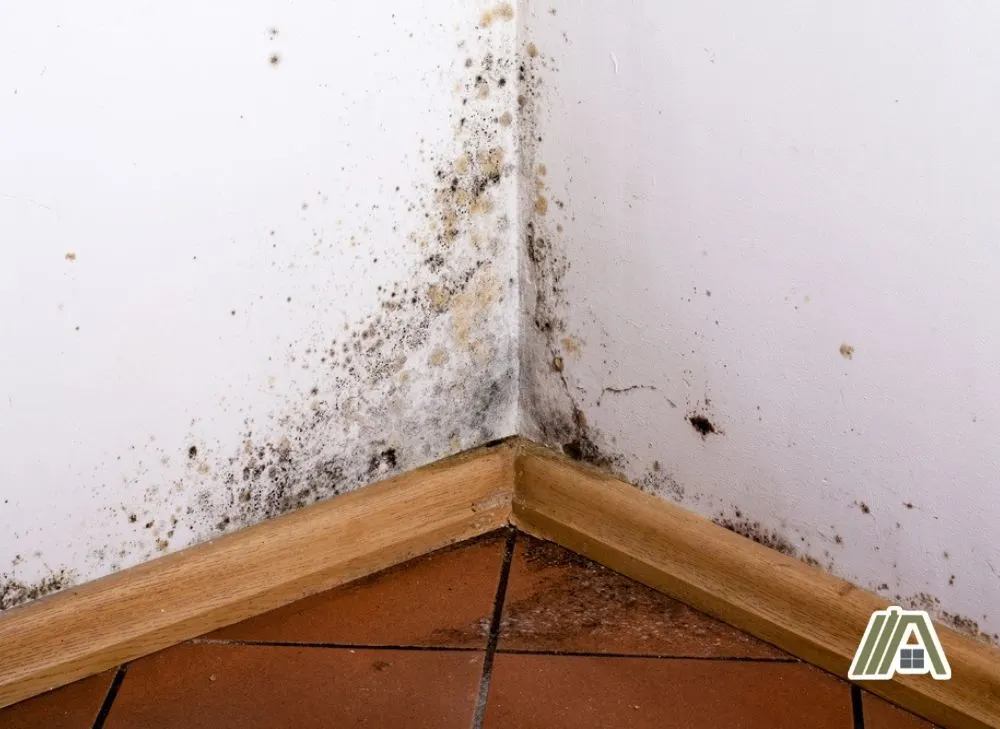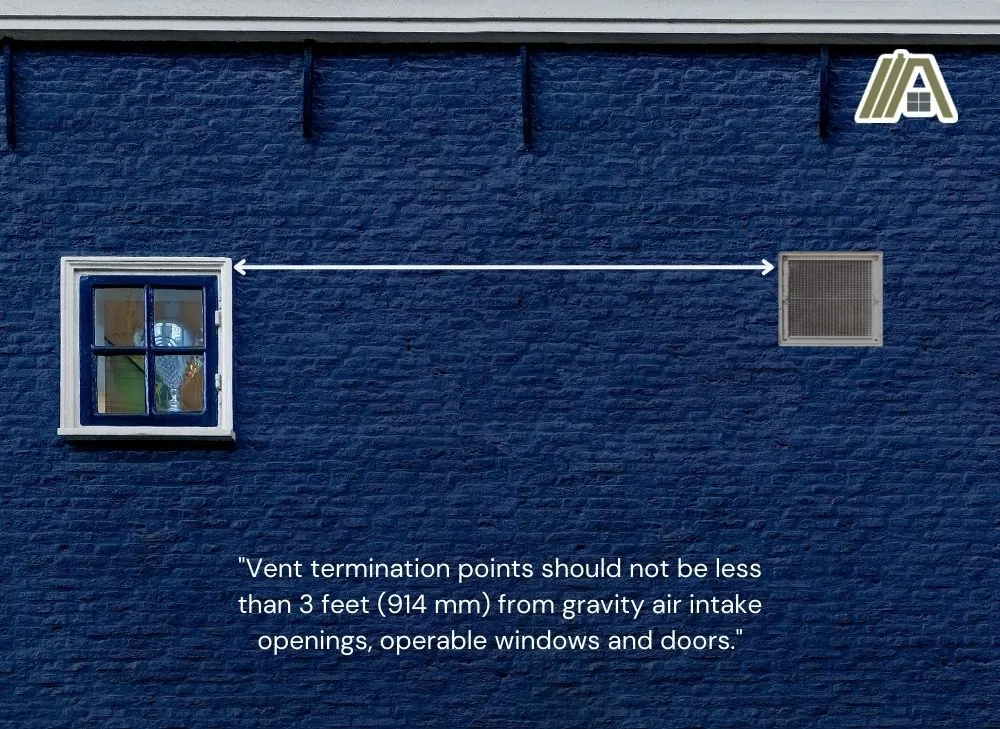Bathroom exhaust fans exhaust hot and moist air that can be damaging to your home. As such, where and how the system terminates is important.
Bathroom exhaust fan termination requirements are outlined in the building codes. This is helpful because you can guarantee compliance by just following these regulations. Yet, the codes can be difficult to understand, so let me help you!

Bathroom exhaust fans must terminate outside, 3 ft away from property lines and 3-10 ft away from openings into the house. Backdraft dampers are required by some local codes, but they are always recommended. Screens are also recommended but not mandatory.
Where to Find the Requirements
Although the International Residential Code (IRC) does not have a specific section on bathroom exhaust fans, they are covered under general exhaust systems, which are discussed in Chapter 15.
Termination points are specifically covered in sections M1501.1, M1504.3, and M1505.2. These sections are what we will be going through in this article.
Before we do, you should note that you will have to check your own local codes as well. Most states in America adopt the IRC (Wisconsin is the exception). But the IRC is an international code and may not be as specific at times because of its intended, more general audience.
So, local adaptations and additions can be made to make sure that the codes are better suited for the area.
Local codes can most easily be found online by searching along the lines of “(whatever area you are in) building codes.” Or you can check out UpCodes.

Calling the local government body is another surefire way of finding the local building codes that apply to you.
Bathroom Exhaust Fans Must Terminate Outside
Bathroom exhaust fans are required to terminate outside of the home. This also means that the termination point can not be in a soffit, crawl space, or attic.
This still applies even if these areas are outside of the building envelope or are themselves ventilated.
Section M1501.1 clearly states:
“The air removed by every mechanical exhaust system shall be discharged to the outdoors in accordance with Section M1504.3. Air shall not be exhausted into an attic, soffit, ridge vent or crawl space.”
Section M1505.2 reiterates that exhaust fans must terminate outside by saying:
“Exhaust air from bathrooms and toilet rooms shall not be recirculated within a residence or circulated to another dwelling unit and shall be exhausted directly to the outdoors. Exhaust air from bathrooms, toilet rooms and kitchens shall not discharge into an attic, crawl space or other areas inside the building.
However, venting through a soffit is allowed because the air is not being released within the home.
Why Outside Termination Is Important
Termination of a bathroom vent outside of a house is important for many reasons.
A vent terminating in the house could lead to moisture damage. This is because a bathroom vent releases warm, moist air. This damp air can then damage numerous features of the home, including wiring, wooden structures, metal supports and fasteners, and insulation.
Damp insulation is less effective at reducing heat flow out of the house and it can also grow mold, although mold is not specific to damp insulation.
Warm damp air that is being vented into a home promotes mold growth on any surface that is exposed to the air. This is because mold thrives in such conditions.

A bathroom fan with a termination point in the house can also increase the temperature of the home, because of the warm air that is being vented. This causes the heating, ventilation, and air conditioning (HVAC) system to work harder.
Having this system work harder can lead to wear and tear more quickly and will increase your monthly utility bills and footprint.
Additionally, warm and damp areas are environments that insects and other pests prefer. A bathroom vent terminating within a home creates this type of environment and welcomes critters.
Foul odors can become more apparent in a home if a bathroom vent terminates inside as well because a bathroom is the location of some bad smells.
Terminal Vent Location Considerations
Due to a termination point releasing potentially hazardous exhaust, you should take notice of where the termination point is located and who it might impact.
Property Lines
Section M1504.3 of the IRC states that in regard to exhaust openings and property lines:
“Not less than 3 feet (914 mm) from property lines.”
This regulation is in place so that fumes that are being released do not impact a neighbor’s household.
All of the issues that you are trying to avoid in your home may be experienced by your neighbor if your bathroom exhaust vent terminates too close to their house.
You also cannot interfere in how they use their property, and hot, moist, and potentially odorous air being pumped into their yard can prohibit them from using this area for recreation, etc.
Passive Air Intakes
A passive air intake is a ventilation system that uses vents placed at exterior windows/walls, which allows for air from the outside to enter the home in a more controlled manner. They are passive because there is nothing driving this movement of air other than natural air currents.
Section M1504.3 of the IRC discusses regulations associated with vent termination points and these passive air intakes. The terminal vent should be:
“Not less than 3 feet (914 mm) from gravity air intake openings, operable windows and doors.”

This distance of three feet is selected because passive air intakes are not as quick to take in air from the outdoors as a mechanical air intake (which will be discussed next).
This is to say the reach of a passive air intake is not as wide, so three feet provides ample room for dissipation.
It is good to be aware of doors and windows (even if there is no passive intake system) as these offer access directly into the home as well.
Mechanical Air Intakes
A mechanical air intake is one that actively pulls air into itself to feed an air-requiring system, such as a heating or cooling unit or a gas-powered appliance.
Section M1504.3 of the IRC says that the exhaust vent should be:
“Not less than 10 feet (3048 mm) from mechanical air intake openings except where the exhaust opening is located not less than 3 feet (914 mm) above the air intake opening. Openings shall comply with sections R303.5.2 and R303.6.”
The distance for a mechanical air intake system is greater than either of the other two regulations described above because a mechanical air intake system sucks air into the system.
The exception of when the vent is located above the intake is because the hot air released from the bathroom exhaust vent will quickly rise away from the mechanical intake.
Are Backdraft Dampers Required By Code?
Backdraft dampers are not required for bathroom fan exhaust vents by the IRC.
That being said, you need to check your local regulations because backdraft dampers serve a really important role, and your state might view it as a mandatory one.
For example, backdraft dampers are required in Nevada.
The Uniform Mechanical Code 2018 of Nevada states that exhaust ducts must be equipped with backdraft dampers (or another motorized damper) that will automatically close when the system is not in use. There are some exceptions, however.
No backdraft damper is needed in Nevada when:
- The exhaust fan is constantly running.
- The ducting is in areas that aren’t cooled or heated mechanically.
- The area that is being served is always under a positive pressure.
A constantly running exhaust fan doesn’t need a damper because the air is always being vented out, so it would never close, making it useless.
Areas that aren’t cooled or heated mechanically don’t need a damper because air coming in or going out would not increase heating or cooling bills and energy consumption.
And lastly, areas at positive pressures (greater than the atmospheric pressure) don’t need a damper because the pressure system ensures one-way airflow.
I wanted to go through the exceptions to give you a greater understanding of what a backdraft damper does. However, a bathroom would not qualify as an exception. It does not run continuously, bathrooms are part of the heated/cooled thermal envelope, and houses typically are not under positive pressure.
The InterNACHI also requires backdraft dampers for bathroom fans.
Backdraft Dampers Are Recommended
Even if the local codes don’t require a backdraft damper, they are highly recommended.
The main reason for this is that the backdraft damper allows airflow out of the home but not back in. This is extremely important in the case of an exhaust termination point because having the exhausted fumes re-enter the home could be dangerous.
The damper also helps to prevent insects and animals from trying to enter the vent when it is not on by closing.
Additionally, the backdraft damper can help prevent cold drafts and loss of heat from the home.
What About Screens?
Screens are not required but can be beneficial.
The main benefit of a screen on a termination vent is to prevent animals and insects from entering the system.
A screen can also be helpful in preventing debris, like leaves, from getting inside the ductwork, which would reduce the overall efficiency and effectiveness of the system because of the obstructions inside of it.
Sources
https://www.petro.com/resource-center/what-is-hvac
https://www.hgtv.com/design/remodel/mechanical-systems/passive-ventilation

